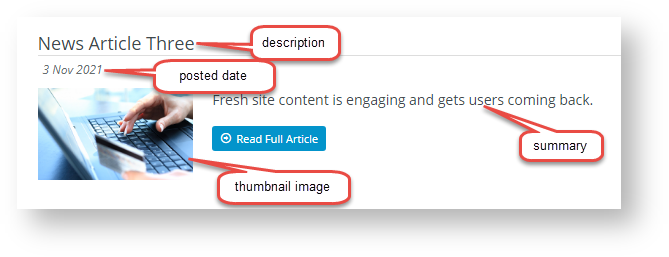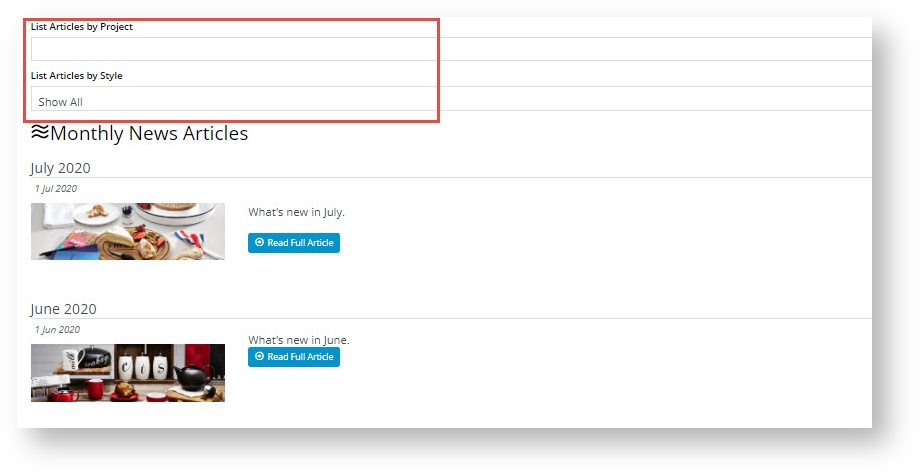...
| Multiexcerpt | ||
|---|---|---|
| ||
| The BPD platform's powerful and flexible Article functionality can be used to publish content that changes based on posted, start and finish dates. Whether it's latest news, blogs or FAQs, our article system can help you present fresh content and communicate more effectively with your customers. |
This Use this guide provides an introduction to understand the key aspects of Article creation and maintenance on your Customer Self Service eCommerce Platform website. If you are an article creator, note that the degree to which you can customise customising article-related layouts depend depends on settings configured by your Admin Administrator and the site version.
1. Article Types
Articles are grouped into various user-defined article types, which can then be selected in article widgets to display. Grouping your articles helps to keep them organised by function or purpose. For example, you might create one article type for FAQs, another for blog posts, and still another for press releases, etc.
...
- In the CMS, navigate to Content → Articles.
- Click Add New Article Type.
- Assign to your new group a Code, a Name, and an optional Icon (for display in the CMS).
- Click Save. Once an article type has been created, you can add articles for it.
...
- In the CMS, navigate to Content → Articles.
- Select the Article Type you want your new article to be grouped to group the article in.
- Click Add New Article.
- Enter a Description for your article. This will display as be the article's title.
- The article's SEO URL, Browser Page Title, and SEO Description will also be auto-populated with the value you enter here. You can change any of these fields if you wish.
- The Posted Date will auto-populate with today's date. If you wish, you can also enter Start & Expiry dates for articles you'd like to display for a set period only.
- Select or upload a thumbnail image for the article. This will be the small image that displays when the an article list of articles is viewed.
- Select or upload the main image for the article. This will be the larger image that displays on the article detail page.
- Enter some 'teaser' text in the Summary section. This is the short-form content displayed when viewing a article list of articles.
- In the Content section, enter the main body of the article. Use the WYSIWYG editing tools to update font sizes, formats, and colours based on your site's style guide.
- Toggle ON Customer filters apply to user's current Customer only? if you only want Users currently in the Customer accounts added in Customer Code filters (step 12) to see this article. If OFF, the User will see the article while in all their Customer accounts.
- Article Filters allow articles to be displayed only to a certain segment of site users. You can enter one or more Filter values: Customer Types, Customer Warehouses, Customer Codes, Bill to Customer Codes, Email Addresses or Roles.
Note NOTE - this This function works only with standard article widgets. It will not work with custom widgets. (TIP - If you do not see this function, it has not been enabled by Admin in Article Feature Settings.)- Features are metadata you define for use with article filtering in an article list page, to help website users find relevant articles. Feature and feature values should be highly meaningful to your article content. Think of a 'feature' as a category and its 'values' as subtypes of the category. As an example, suppose your business sells homewares and produces feature articles on products and designs for different rooms. A 'feature' could then be 'room type' with , and values such as , 'bathroom', 'bedroom', 'loungeroom', etc. Articles can be tagged with particular features and values. Using the Features functionality, visitors to your site can filter for articles about decorating a particular room type, e.g., 'bathroom' or 'bedroom'.
You can add as many features as you require.
In Feature, enter a name for the category. In Value, enter the subtype of this category. Note TIP - for For the filters to display when articles are listedin an article list, see the how-to guide on Adding a Feature Filter.
How site visitors use feature filters:
13. CTo save the article, click Save & Exit.
3. Article
...
List Page Layout
An article list page displays a list of grouped articles to your website users, with links to take them to each article's content are displayed. In short, it depends on the template used. There are 3 standard built-in templates for either articles or article lists (in Content → Pages & Templates). The simplest option is to use the default non-zoned layouts supplied for an article list (Article List Page) and article content.
...
. A default article list page template comes standard for your website. This 'Article List Page' template is automatically used if the 'Use Zoned Article Template?' is disabled or
'Use Zoned Article Layout?' is not enabled in the widget used to render the list, either the Article List or Article List All
...
widgets. The default template is accessed via Content → Pages & Templates → Articles.
| Expand | ||
|---|---|---|
| ||
If the zoned template setting is enabled, the article list page defaults to the Article List Item Zoned template.
4. Article Layout
An, article's layout depends on the template used. The simplest option is to use the default non-zoned layout supplied for an article list. If you don't specify a template, this will be the layout of an article. You do not have to mess around with templates.
| Expand | ||
|---|---|---|
| ||
To customise an article layout, the 'Use Zoned Article Template' setting
...
must be enabled in Settings. Your website is supplied with a standard zoned article template - the Article Page Zoned template. This template defaults if zoned templates is used and no other templates have been selected for the article/article group.
Depending on your site's requirements and version, you can use customise article templates, edit them, or even override them and use custom article templates. For detailed help with these templates, see Article Templates help.
5. Article
...
Widgets
Each of the above templates uses various widgets to display the article content. For example, your article page zoned template might have the following widgets:
...










